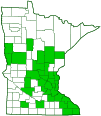spotted beebalm
(Monarda punctata var. villicaulis)
Conservation • Wetland • Description • Habitat • Ecology • Use • Distribution • Taxonomy
Description |
||
Spotted beebalm, also called horsemint, is a 12″ to 36″ tall, erect, short-lived perennial forb that rises from a taproot. The stems are erect, leafy, and square. They are usually unbranched except for short, leafy branches arising from the leaf axils. They are densely covered with long, soft, spreading hairs. The leaves are opposite, lance-shaped to narrowly oblong, ¾″ to 3″ long, and ⅛″ to ½″ wide. They are on slender, ¼″ to 1¼″ long leaf stalks. The upper surface is sparsely to moderately hairy. The lower surface is densely hairy. The margins of lower and middle leaves are shallowly toothed, those of upper leaves often untoothed. The inflorescence is 2 to 5 small, compact, head-like flower clusters (glomerules) at the end of the stem and branches. One whorl is at the end of the stem, the others originate at upper leaf axils. Each whorl is subtended by 5 to 10 showy modified leaves (bracts). The bracts are leaf-like, lance-shaped to egg-shaped, spreading or bent backward, ⅝″ to 1½″ long, and ¼″ to ⅝″ wide. They taper to a sharp point and are toothed only near the tip. The upper side is mostly pale green to mostly white, sometimes tinged with pink or purple. The underside is pale green. The flowers are ⅝″ to 1½″ long. There are 5 sepals, 5 petals, and 2 stamens. The sepals are green and are fused at the base into a 3 ⁄16″ to ⅜″ long calyx tube then separated at the tip into 5 triangular, spreading teeth. The petals are pale yellow with purple spots. They are fused at the base into a slender corolla tube then separated at the tip into 2 widely spreading lips. The upper lip has is keeled and strongly arched over the stamens. The lower lip has 2 small lateral lobes and a large central lobe that is sometimes notched. The lower lip often has small purple spots. The stamens do not extend beyond the corolla tube. The fruit is 4 oblong or egg-shaped, smooth, brown nutlets. |
||
Height |
||
12″ to 36″ |
||
Flower Color |
||
Pale yellow with purple spots |
||
Similar Species |
||
Habitat |
||
Dry. Full sun. Sandy soil. |
||
Ecology |
||
Flowering |
||
July to September |
||
Pests and Diseases |
||
|
||
Use |
||
|
||
Distribution |
||||
|
Sources |
|||
| 6/20/2023 | ||||
Nativity |
||||
Native |
||||
Occurrence |
||||
|
||||
Taxonomy |
|||
| Kingdom | Plantae (Plants) | ||
| Subkingdom | Pteridobiotina | ||
| Phylum | Tracheophyta (Vascular Plants) | ||
| Class | Magnoliopsida (Dicots) | ||
Order |
Lamiales (Mints, Plantains, Olives, and Allies) | ||
Family |
Lamiaceae (Mint) | ||
| Subfamily | Nepetoideae | ||
| Tribe | Mentheae | ||
Subtribe |
Menthinae (balms, mints, and thymes) | ||
| Genus | Monarda (beebalms and bergamots) | ||
| Species | Monarda punctata (spotted horse mint) | ||
Synonyms |
|||
Monarda punctata ssp. punctata var. villicaulis Monarda punctata ssp. villicaulis |
|||
Common Names |
|||
dotted beebalm dotted monarda horse-mint horsemint spotted bee balm spotted beebalm spotted horse mint spotted horsemint |
|||
Glossary
Axil
The upper angle where a branch, stem, leaf stalk, or vein diverges.
Bract
Modified leaf at the base of a flower stalk, flower cluster, or inflorescence.
Calyx
The group of outer floral leaves (sepals) below the petals, occasionally forming a tube.
Corolla
A collective name for all of the petals of a flower.
Glomerule
A dense, cluster; a small, compact, head-like cyme.
Keeled
Folded, as in a grass blade, or with a raised ridge, as in a grass sheath; like the keel of a boat.
Rhizome
A horizontal, usually underground stem. It serves as a reproductive structure, producing roots below and shoots above at the nodes.
Visitor Photos |
|||||
Share your photo of this plant. |
|||||
| This button not working for you? Simply email us at info@MinnesotaSeasons.com. Attach one or more photos and, if you like, a caption. |
|||||
|
|||||
MinnesotaSeasons.com Photos |
|||||
Plant |
|||||
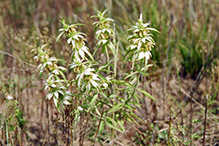 |
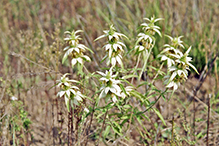 |
||||
 |
|||||
Inflorescence |
|||||
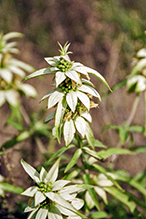 |
|||||
Late Season |
|||||
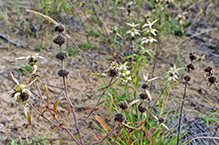 |
|||||

Slideshows |
||

Visitor Videos |
|||
Share your video of this plant. |
|||
| This button not working for you? Simply email us at info@MinnesotaSeasons.com. Attach a video, a YouTube link, or a cloud storage link. |
|||
Other Videos |
|||
| Monarda punctata, Horsemint, Punktierte Indianernessel, Pferdeminze, perennial, Wildstaude Robert Jondalar |
|||
About
Published on Jul 16, 2012 gentiana |
|||
| Monarda punctata Horse Mint dullard69 |
|||
About
Published on Sep 6, 2012 A nice flowering native to the southeast U.S. and elsewhere. |
|||
| Nature in a Minute, Episode 9 - Dotted Horsemint Kevin Mims |
|||
About
Uploaded on Oct 24, 2011 No description available. |
|||
| Horsemint the Great Attractor for pollinating insects Christopher Stokes |
|||
About
Published on Aug 15, 2013 just letting the camera watch this Horsemint and seeing all the different insects who love it. bees love it. wasps, and hornets. if you want lots of bees plant this great plant sharing what i seen today with you. if you have some time please leave a comment below. and Please Subscribe to my channel and thank you very much for watching my videos.. |
|||

Visitor Sightings |
|||||
Report a sighting of this plant. |
|||||
| This button not working for you? Simply email us at info@MinnesotaSeasons.com. Be sure to include a location. |
|||||
|
|||||
MinnesotaSeasons.com Sightings |
|||||

|
Created: Last Updated: © MinnesotaSeasons.com. All rights reserved. |
